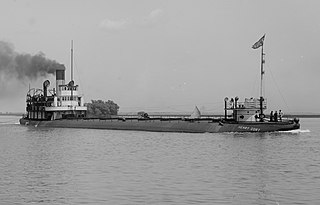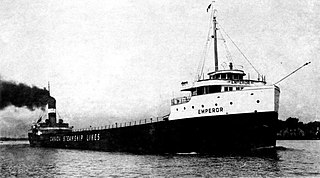The SS Anna C. Minch was a cargo carrier which foundered, broke in two, and sank in Lake Michigan during the Armistice Day Blizzard on 11 November 1940. The Anna C. Minch was a steam-powered, steel-hulled bulk freighter constructed in 1903 by the American Ship Building Company at Cleveland, Ohio.

SS Cyprus was a lake freighter that sank during a gale storm on Lake Superior on 11 October 1907. The ship went down in 460 feet of water at 46.79°N 85.60°W, about 8 miles north of Deer Park in Luce County, Michigan. All but one of the 23 members of the crew perished.

The SS Regina was a cargo ship built for the Merchant Mutual Line and home ported in Montreal, Quebec. Named after Regina, Saskatchewan, Regina had a tonnage of 1,956 gross register tons (GRT) and a crew of 32.

SS M.M. Drake was a wooden steam barge that towed consorts loaded with coal and iron ore on the Great Lakes. She came to the rescue of the crews of at least four foundering vessels in her 19-year career only to meet the same fate in her final rescue attempt. Drake sank in 1901 off Vermilion Point after a rescue attempt of her consort Michigan. Her rudder, anchor, and windlass were illegally removed from her wreck site in the 1980s. They are now the property of the State of Michigan. The rudder is on display as a loan to the Great Lakes Shipwreck Museum and the anchor and windlass are on loan for display to Whitefish Township Community Center. The wreck of Drake is protected as part of an underwater museum in the Whitefish Point Underwater Preserve.
SS Novadoc was one of three Great Lakes freighters lost in the Armistice Day Storm of 11 November 1940. SS William B. Davock and Anna C. Minch both foundered that same night with complete loss of their crews. All three ships went down between Little Point Sable and Pentwater, Michigan. Unlike the crews of the Davock and Minch, most of the Novadoc′s crew survived the sinking due to the bravery of some local fishermen.

SS Ira H. Owen was a steel-hulled American lake freighter in service between 1887 and 1905. One of the first steel lake freighters, she was built in 1887 in Cleveland, Ohio, by the Globe Iron Works Company, and was built for the Owen Line of Chicago, Illinois. Early in her career, Ira H. Owen carried iron ore from Escanaba, Michigan. In April 1898, Ira H. Owen was chartered by the Baltimore & Ohio Railroad. She was sold to the National Steamship Company of Chicago, on December 30, 1899, for whom she frequently carried coal and grain. Throughout her career, Ira H. Owen was involved in multiple accidents and incidents.

The Henry Cort was a 320-foot (98 m) long whaleback freighter. It sank four times during its career; finally running aground at Muskegon, Michigan in November, 1934. The ship broke apart over the winter and was scrapped in 1935.

SS D.R. Hanna was a 552-foot (168 m) long American Great Lakes freighter that operated on the Great Lakes from November 12, 1906 to her sinking on May 16, 1919 after a collision with Quincy A. Shaw. D.R. Hanna was like many other freighters, and was used to haul bulk cargoes such as iron ore, coal and grain.

The Australasia was a wooden-hulled American Great Lakes freighter that served on the Great Lakes of North America between her construction in 1884 to her burning and sinking in 1896. On October 18, 1896, while loaded with coal, the Australasia sank in Lake Michigan near the town of Sevastopol, Door County, Wisconsin, United States, after burning off Cana Island. On July 3, 2013, the wreck of the Australasia was added to the National Register of Historic Places.

The SS Muskegon was a wooden hulled American passenger and package freight vessel that burned down on October 6, 1910 off the coast of Michigan City, Indiana in LaPorte County, Indiana, United States while unloading a cargo of sand. On April 26, 1989 the remains of the Muskegon were listed on the National Register of Historic Places.

The Harriet B. was a wooden-hulled barge that served on the Great Lakes of North America, originally as the railroad ferry Shenango No.2, then a bulk carrier and finally as an unpowered barge. She sank four miles off Two Harbors, Minnesota, on May 3, 1922, after being rammed by the steel freighter Quincy A. Shaw. Her wreck was accidentally located upright and intact in 2005 in 656 feet (200 m) of water. On August 9, 2018, the wreck of the Harriet B. was listed on the National Register of Historic Places.

SS Etruria was a steel hulled lake freighter that served on the Great Lakes of North America from her construction in 1902 to her sinking in 1905. On June 18, 1905, while sailing upbound on Lake Huron with a cargo of coal, she was rammed and sunk by the freighter Amasa Stone 10 miles (16 km) off Presque Isle Light. For nearly 106 years the location of Etruria's wreck remained unknown, until the spring of 2011 when her wreck was found upside down in 310 feet (94 m) of water.

SS S.R. Kirby was a composite-hulled bulk carrier that served on the Great Lakes of North America from her construction in 1890 to her sinking in 1916. On May 8, 1916, while heading across Lake Superior with a cargo of iron ore and the steel barge George E. Hartnell in tow, she ran into a storm and sank with the loss of all but two of her 22-man crew off Eagle Harbor, Michigan. For over 102 years the location of S.R. Kirby's wreck remained unknown, until June 2018, when her wreck was discovered by the Great Lakes Shipwreck Historical Society (GLSHS) in 825 feet (251 m) of water, completely broken up.

SS Russia was an iron-hulled American Great Lakes package freighter that sank in a Lake Huron gale on April 30, 1909, near DeTour Village, Michigan, with all 22 of her crew and one passenger surviving.

SS John V. Moran was a wooden-hulled American package freighter in service between 1888 and 1899. She was built in 1888 in West Bay City, Michigan, by F.W. Wheeler & Company. She was built for Ward's Crescent Transportation Company of Detroit, Michigan, and was operated as part of his Detroit & Lake Superior Line. She was built to haul both bulk, and package freight. Throughout the 1893 shipping season, John V. Moran ran between Buffalo, New York, and Duluth, Minnesota. She was sold for the first time in 1895 to the Union Transit Line of Buffalo, and once again in 1898 to the Crosby Transportation Company of Milwaukee, Wisconsin.

SS John Mitchell was a steel-hulled, American lake freighter in service between 1907 and 1911. She was built in 1906 by the Great Lakes Engineering Works in St. Clair, Michigan, for the Cornell Steamship Company of Chicago, Illinois, which was managed by C.W. Elphicke. She entered service in 1907, and had a sister ship named William B. Davock. Throughout her career, John Mitchell carried iron ore and coal. On October 4, 1908, she ran aground at Indiana Harbor, Indiana, while loaded with iron ore.

SS Ironsides was a wooden-hulled American package freighter in service between 1864 and 1873. She was built in 1864 in Cleveland, Ohio, by either Ira Lafrinier or Quayle & Martin. She was built for John E. Turner, also of Cleveland, and operated as part of the Cleveland & Lake Superior Line. She had an identical sister ship named Lac La Belle. Ironsides operated between Cleveland and Lake Superior for a number of years, and was sold several times. In 1869, she was sold to Nathan Englemann of Milwaukee, Wisconsin, and operated between Milwaukee and Grand Haven, Michigan. In 1871, she became part of the Englemann Transportation Company.

SS Emperor was a steel-hulled Canadian lake freighter in service between 1911 and 1947. She was built between 1910 and April 1911 by the Collingwood Shipbuilding Company in Collingwood, Ontario, for Inland Lines, Ltd., of Midland, Ontario. She entered service on May 3, 1911. Emperor was sold to Canada Steamship Lines of Montreal, Quebec. Under the ownership of Canada Steamship Lines, she carried a wide variety of cargoes, but most frequently iron ore to Point Edward, Ontario, where it would be transported to Hamilton, Ontario, by train. After the opening of the fourth Welland Canal, Emperor carried the ore directly to Hamilton. She was involved in several accidents throughout her career.

SS Chester A. Congdon was a steel-hulled American lake freighter in service between 1907 and 1918. She was built in 1907 by the Chicago Shipbuilding Company of South Chicago, Illinois, for the Holmes Steamship Company, and was intended to be used in the grain trade on the Great Lakes. She entered service on September 19, 1907, when she made her maiden voyage. In 1911, Salt Lake City was sold to the Acme Transit Company. A year later, she was transferred to the Continental Steamship Company, and was renamed Chester A. Congdon, after lawyer and entrepreneur Chester Adgate Congdon. She was involved in several accidents throughout her career.

















